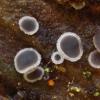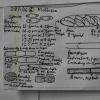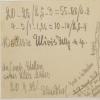
18-12-2025 21:17
Pol DebaenstThe identification took me to Byssonectria deformi

15-12-2025 07:09
 Danny Newman
Danny Newman
indet. Rutstroemiaceae sp. on unk. fallen leavesMc

19-12-2025 10:10
Patrice TANCHAUDBonjour, récolte réalisée en milieu dunaire, a

18-12-2025 17:23
 Bruno Coué
Bruno Coué
Bonjour,je serais heureux d'avoir votre avis sur c

18-12-2025 18:07
Margot en Geert VullingsThese plumes were found on rotten wood.They strong

17-12-2025 18:35
 Michel Hairaud
Michel Hairaud
Bonjour à tous/Hi to everyone I am passing along

15-12-2025 15:48
 Danny Newman
Danny Newman
Melanospora cf. lagenaria on old, rotting, fallen

15-12-2025 15:54
 Johan Boonefaes
Johan Boonefaes
Unknown anamorph found on the ground in coastal sa

15-12-2025 21:11
 Hardware Tony
Hardware Tony
Small clavate hairs, negative croziers and IKI bb
I have found a sample of what is possibly an interesting Mollisia growing on a branch of Ulex europaeus.
It seems that all of the rows of parallel cells in the upper part of the excipulum are almost as refractive as the paraphyses and these, terminating in swollen end cells might actually be hairs with refractive VBs. Below these rows of refractive cells are some brown cells around the base of the fruit bodies.
The KOH reaction of a fruit body is strongly yellow.
The spores are bipolar, with a few small drops (between 4 and 10) towards each pole.
I operated the provisional Mollisia key created by A. Gninder. Here, I followed the path -
1a On wood, bark (2)
2b Ascus reaction bb (5)
5b Subhymenium built of hyaline hyphae (as 5a indicates KOH negative) (7)
7b Marginal cells less conspicuous, KOH reaction yellow or negative (10)
10a KOH reaction distinctly yellow (11)
11b Spores not septate within mature asci, of other size (12)
12c Oil either 1 (many tiny droplets) .........., if 1 then ascus reaction strong bb
= Mollisia perparvula
From this key, possibly the studied Helsinki material was of Mollisia perparvula, perhaps from Karsten's type material?
Another option could be Mollisia ulicis, if in the key, option 12a was followed, with oil 2-3(4). I think that the spores in my sample are only just reaching the lower end of the quoted range for this species.
This is not a species which I see described in the literature. In Index/Species Fungorum the current name is given as Cistella perparvula, which seems strange, because I would expect granulate hairs in the genus Cistella. Absent in this sample.
I have attached a sketch of the microscopy and photo of the fruit bodies and wonder whether anyone has any ideas about my sample.
Thank you,
With Best Wishes,
Peter.

Hello,
yes this is what I call Mollisia ulicis, a species which has been showen to me by J.-P. Priou and which I have found in west-France myself, always on Ulex. it is not rare on Ulex.
I'm not sure if the type of Feltgen has been investigated by someone (Zotto? Guy?) to proof wether this concept of our french friends, which is based on the description in GRELET, is identical with the original M. ulicis Feltgen.
The oil content is sometimes 2, sometimes there are bigger drops inbetween and it reaches 3. If also have a spore foto of this species with only small oil drops just as in your foto.
The spores often become septate when outside the asci, may be this is to be verified (best seen in Lugol sometimes).
best regards,
Andreas
Thank you for your reply and for help with the identification.
I must admit that I was not sure about the oil percentage, with only such small drops. I will check for any spores which might have developed septa outside the asci.
Because of the host, I thought that M. ulicis was a possibility, but have not found a species description to compare.
This sample was found in the English Midlands. I am yet not sure whether there are previous British records.
With Best Wishes,
Peter.

Here is the link to the LUX-herbarium
https://www.mnhn.lu/science/donnees/information-sur-le-patrimoine-naturel/information-sur-le-patrimoine-naturel-projets-de-recherche/biogeoportail/biocase/recherche-biocase-faune-flore-fossiles/
You must enter M*, not Mollisia, the latter doesm't work on my computer.
Here is Feltgens sketch. Another label bears only the name M. discolor, and I must say that this could be true because of the oil drops and of the dark margin without mention of hairs.



